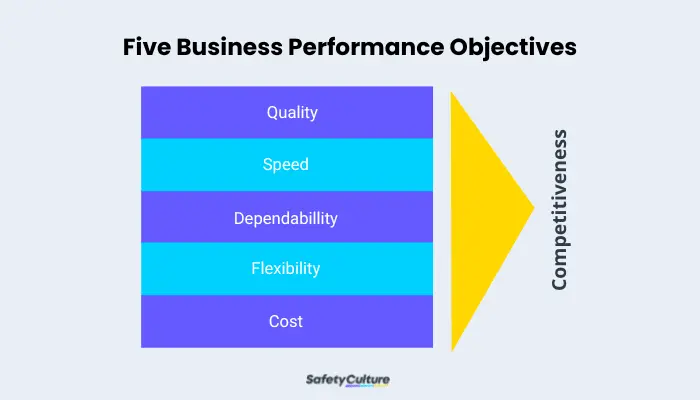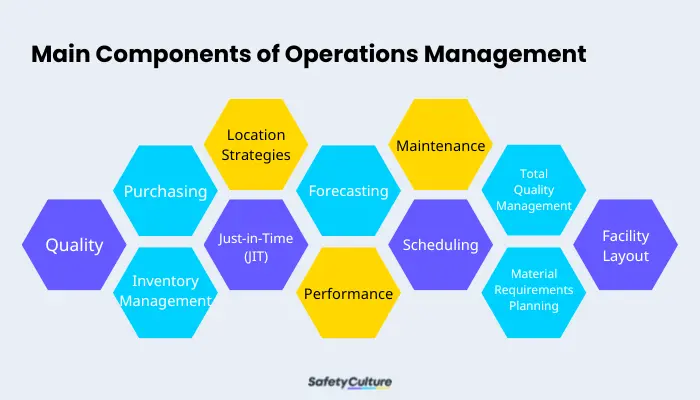What is Operations Management System (OMS)?
Operations Management System (OMS) is a collection of processes and strategies for making the operations of organizations more efficient.
While Operations Management (OM) focuses on how the organization will transform inputs or resources into outputs (which are products, goods, or services), the role of OMS is geared towards maximizing the organization’s performance in managing the business operations to reach the highest level of efficiency possible.
Yokogawa defines OMS as a system that, “helps to ensure safe, reliable and efficient [plant] operations and regulatory compliance by digitization of information related to key operations management practices. [This] It results in improved productivity through standardized work practices, streamlined processes, plus improved communications and coordination across departments.” Additionally, OptimoRoute explained OMS as a “business framework that charts the path to increased productivity and better quality control at a reduced cost.”
5 Key Business Performance Objectives
When discussing the organization’s performance, the 5 key business performance objectives should be understood. Business performance objectives help the organization to stay focused. To successfully achieve increased productivity and efficiency in an organization, it should have an indicator of the quality of its products or services. These objectives provide competitive advantages for any organization. They are:

Five Business Performance Objectives for Operations Management System
- Quality—the indicator of an organization’s ability to meet the customer’s expectations
- Speed—the indicator of the customer’s decision in purchasing or availing; the faster they receive the product or service, the more likely they will avail again
- Dependability—the indicator of how much the customers trust in the commitment of an organization
- Flexibility—the indicator of how well an organization can adapt to changes
- Cost—the indicator of an organization’s productivity; if the production cost is lower, the price of the products or services will also be lower for customers
Achieve operational excellence
Cultivate a culture of excellence with our digital solutions that enhance efficiency, agility, and continuous improvement across all operations.
Explore now12 Main Components of Operations Management
There are 12 major components of operations management that must be in place in order for the organization’s performance to be maximized and its efficiency to be at its highest. Each of these components contributes to the achievement of the organization’s objectives. For effective operations management, it is important to understand the different components that make up the entire operations and how they work together. They are:

Main Components of Operations Management
- Forecasting—relates to the organization’s use of past data, figures, statistics, and other historical details in determining the next steps or decisions to take for production; forecasting is important in order to calculate how much of a particular product should be produced.
- Location Strategies—this relates to the organization’s selection of a location to grow their business.
Factors in selecting location:- location should be in proximity to raw materials or human resources
- location should provide adequate space for inventory or manufacturing
- location should help in reducing costs, such as transportation costs, and other potential risks
- Maintenance—this relates to the organization’s scheduling of regular maintenance checks, inspections, auditing, and adjustments for the machines and equipment; this creates a safe environment or workplace for employees and minimizes the risk of equipment failures or breakdown.
- Purchasing—this relates to the organization’s capacity to meet future market demand by ensuring that the organization has a sufficient supply of raw materials for manufacturing purposes.
- Scheduling—this relates to the organization’s proper delegation of assignments or job orders to appropriate employees or machinery; the right assignment of tasks to the right labor resources will reduce the cost of overall production.
- Total Quality Management (TQM)—this relates to the organization’s strategy for creating a customer-focused and process-focused organization; this involves improving the productivity of all employees and activities of the organization in order to fulfill customer expectations.
- Materials Requirements Planning (MRP)—this relates to the organization’s seamless production process of ensuring that the right amount of materials are supplied at the right time. MRP is the process of taking inventory of the stocks you presently have, identifying which extra materials are needed, and scheduling either production or the acquisition of those materials.
- Quality—this relates to the organization’s consistency in providing high-quality goods and services that meet the customer’s expectations.
- Just-In-Time (JIT)—this relates to the organization’s strategy of manufacturing goods “just in time” or only whenever they are ordered or purchased.
- Process and System Performance—this relates to the organization’s measurement of their performance through analysis of goods produced in their expected time of production to determine where their processes are falling short.
- Layout of Facilities—this relates to the organization’s use of its workflow to minimize waste in movements of items to facilities that can be taken out of the flow.
- Inventory Management—this relates to the organization’s ability to keep track of its stocked items and ensure that they have the resources they need at the right time.
Benefits of Establishing Operations Management System (OMS)
As it grows in size and complexity, every organization starts to become more challenging to manage. The complexity of managing an organization increases when the number of things that need to be managed increases, such as the number of employees, services, programs, or business processes. The ability of a business to turn assets into profits, inventories into goods, and supply chains into cash flow is enhanced by the use of an OMS.
Below are the benefits of establishing OMS in the organization:
- Removes complexity in the operations
Business complexity has an effect on organizational performance. With an established OMS, organizations will be able to streamline all the processes that may be causing additional costs or waste of time and labor. It minimizes time wasted and helps in cutting unnecessary expenses that might crop up because of using slow and ineffective business processes. - Reduces cost and increases profit margin
A reduction in the duration of the production cycle allows for more products to be produced in less time, therefore increasing profit margins for the organization. One way to effectively reduce the cycle time is incorporating lean manufacturing in your organization’s processes, and conducting an analysis of every step in the process, resulting in reduced cost. This leads to more profitability and lower product pricing, which leads to higher sales. - Increase productivity among workers
Operations management systems ensure that your production process is running effectively and enhances your existing workflow by seeing what’s working and what isn’t. OMS assist organizations in efficiently managing labor assets during the manufacturing and distribution process in order to maximize revenue. - Promotes collaboration among different departments
Operations management systems allow different departments in an organization to work together to achieve business objectives and improve management systems for better results. An OMS merges together the collection of past data, processes, customer’s expectations and their requirements for the successful and holistic management of a business. - Minimizes waste
Organizations can gain a better understanding of what is necessary and what isn’t in their business processes by implementing an OMS. It also provides an opportunity to analyze the organization’s costs and conduct an internal audit to identify opportunities for improvement.
Levels of Review
According to Chris Seifert, Partner of Operational Excellence Practice at Wilson Perumal & Company, there are three fundamental types of review for OMS—self-assessing, internal auditing, and third-party auditing.
- Self-assessment—this pertains to assessing the organization’s own performance; it is advised that businesses should only conduct self-assessment if there was a management system implemented before OMS as a frame of reference.
- Internal audits—this pertains to conducting an audit to assess each unit and their processes, to inspect the management, and to evaluate compliance within the organization to regulatory requirements; this is also a way to check and monitor the stability of the organization.
- Third-party audits—this pertains to assessing the organization’s management systems for the purpose of providing recommendations for improvements.
Integrate SafetyCulture (formerly iAuditor) to Your Operations Management System
Establishing an OMS in your organization may require you to automate and digitize your processes to achieve increased operational efficiency in all operations. Reach the highest level of efficiency by integrating SafetyCulture, the best operations management app for conducting paperless assessments, inspections, and audits for your business.
With SafetyCulture, project managers, supervisors, supply chain managers, audit teams, and operations professionals can:
- Conduct internal auditing to help the business identify areas for improvement in quality and operations. This will help in achieving the performance objectives set for the organization using the Quality Objectives Template Checklist.
- Customize an inspection checklist and use it to ensure that your manufacturing processes are running smoothly.
- Provide easy access to data with cloud-based recordkeeping in a mobile app.
- Monitor production and easily communicate with your team in addressing and capturing issues such as problems with the maintenance of machinery and equipment.
- Train employees on proper OMS procedures for a more efficient workflow.
- Manage assets wherever and whenever to ensure OMS effectiveness at all times.
Boost Collaboration Using Heads Up
Increase the potential for collaboration with Heads Up, the newest feature from SafetyCulture. Send engaging communications at scale and enable comments and questions from all employees or a select group such as a team or department. Start actively building relationships based on trust and confidence between workers and executives to close the communication gap and get jobs done without any unnecessary obstacles.



